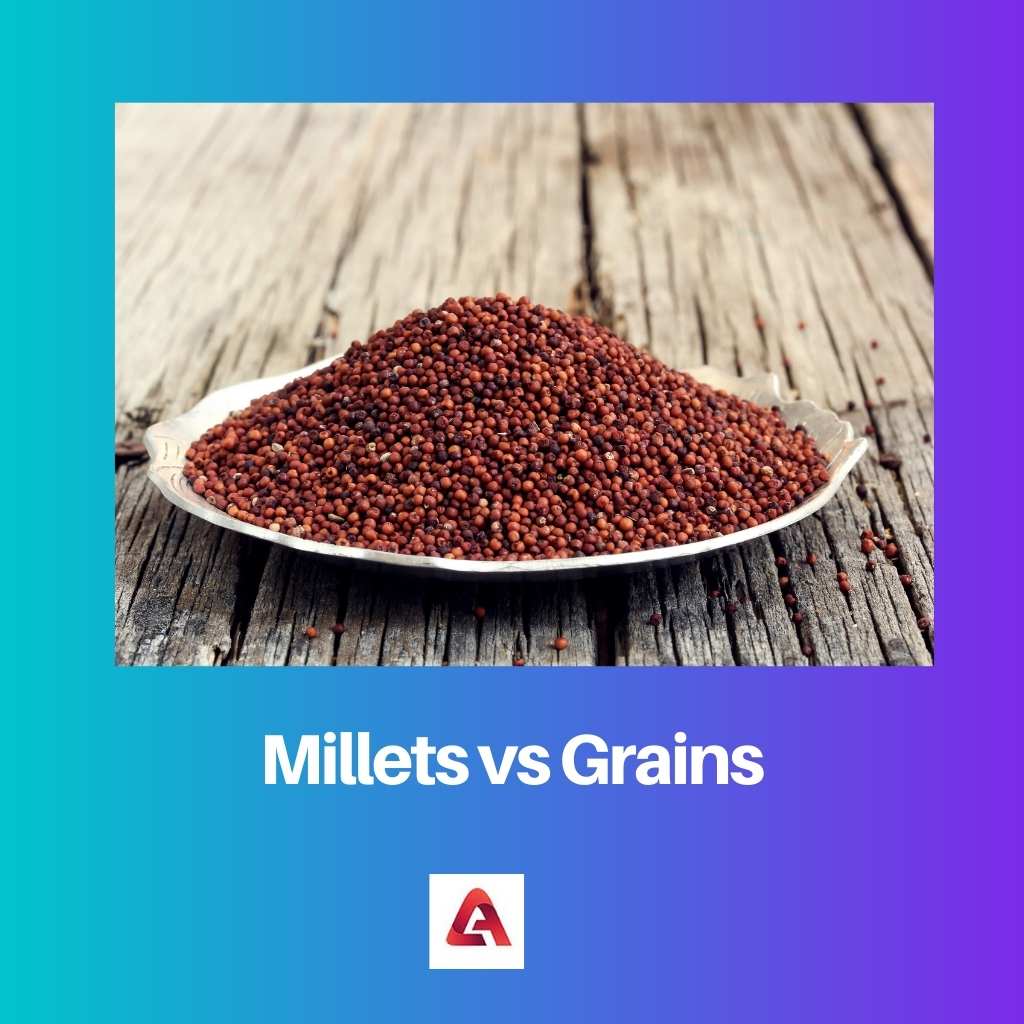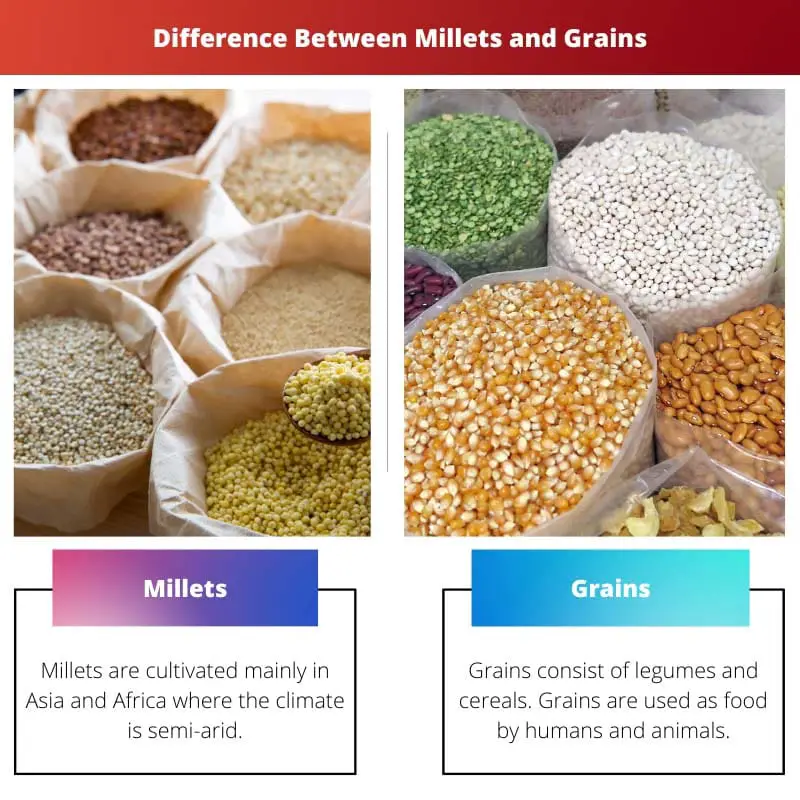Plant parts that are considered edible are consumed as food by people. Seeds, fruit, stem, flower, and roots of specific plants are eaten.
Grains are seeds of plants that are consumed as food. Plants that yield grains are cultivated and grains are marketed by farmers. Rice, wheat, barley, and millet are types of grains.
Key Takeaways
- Millets are a group of small-seeded, drought-resistant cereals, rich in nutrients and considered more environmentally friendly than other grains.
- Grains are a broader category of cereal crops, including wheat, rice, corn, and barley, stapled foods worldwide.
- Millets offer an alternative to conventional grains for those seeking greater nutrient density and a lower environmental impact.
Millets vs Grains
Millets are a type of small-seeded grasses that are commonly used in many traditional cuisines around the world, particularly in Asia and Africa. Grain is a general term used to describe any type of cereal crop that is grown for food. This can include wheat, rice, corn, barley, etc.

Millets are cultivated mainly in Asia and Africa where the climate is semi-arid. It is a famous crop in developing countries like India, Mali, etc.
Millets are highly productive and take only less time to grow and mature. Some types of millet plants are indigenous to some parts of the world. Pearl Millet is indigenous to India.
Grains consist of legumes and cereals. Grains are used as food by humans and animals. Grains are more durable than fruits and vegetables so they have much importance among farmers.
They can be harvested mechanically and transported without much loos like that of fruits. Grains are used to make flour that can be baked into bread or used for other food making.
Comparison Table
| Parameters of Comparison | Millets | Grains |
|---|---|---|
| Countries | India, China, Nigeria | Australia, China, India, US, Philippines |
| Types | Sorghum, Finger millet, Little millet, Pearl millet | Rice, Wheat, Rye, Corn, Barley, Oats |
| Food | Alcoholic beverages, candied puffs, porridge | Bread, Sushi, Cakes |
| Nutrients | Phosphorus, Magnesium, Fiber, Vitamins | Fiber, Vitamin B, C, and D |
| Health benefits | Weight loss, Lowers glucose level, boost immunity | Lowers cholesterol, Boosts cardiac health, protects against stroke |
What are Millets?
Millets are one of the food grains consumed since an early time by humans. They are taken from an annual plant growing in warm conditions. These plants of the grass family are highly drought resistant.
Millets were initially cultivated and consumed by people inhabiting Asia, and Africa. It has been found that millets were cultivated in larger amounts than rice in countries like China and Korea.
Two varieties of Millets have been found to be cultivated in India in early times. These species are Paspalum scrobiculate and Panicum sumatrense.
They are commonly called little millet and Kodo millet. Texts about millets have been found in Indian scriptures like Yajurveda. It is believed that millet cultivation in India started around 1200 BCE.
Agricultural research institutes in various countries are researching Millets. Since millets are grown only around drought and dry conditions they are ideal to grow in places near the Sahara desert.
But millets crops that are irrigated and provided fertilizers have shown greater yield. India is the top producer of Millets. Millet is used to producing fermented beverages like rakshi. Millet flour is used along with sorghum flour to produce flatbread in India.
Finger millet known as Raghi is used to make soups and fed to children in South India. Millet porridge is eaten savory with meat or eaten sweet with milk. Some millets are gluten-free and added to diets.

What are Grains?
Grains are dry seeds and are easy to transport and store. After being harvested, they are stored in silos for the long term. They are grounded or pressed for obtaining flour or oil.
Grains are grounded in mills using machinery. Grains are in greater demand than other food products like vegetables and fruits.
Rice, Barley, Millets, Wheat, Corn, Oats, and Sorghum are some of the examples of Grains. The Bran of the grains is rich in fiber. Oats are rich in beta-glucan.
Oats can regulate blood glucose levels and it is consumed widely by diabetic patients. It also decreases cholesterol and is good for heart health.
Rice is one of the widely cultivated grains. It is very common in Asia’s populated countries like China and India. Rice varieties are very diverse and grown worldwide.
Brown rice, Basmati, Jasmine rice, Arborio rice, etc are some of the Rice varieties. Wheat is a grain that is used widely and so cultivated in higher amounts.
People working in grain storage silos can however face dangers like being entrapped in grains. This is a situation in which people can’t remove themselves from the pile of grains.
People allergic to husks cannot work in these types of places because the processing involves the removal of extra debris from grains that can cause hypersensitivity reactions.

Main Differences Between Millets and Grains
- Millets are obtained from plants belonging to Panacea while Grains are diverse and obtained from different types of plants
- Millet is used to make porridge, flatbread, soup, etc. Whereas, Grains are used in making bread, Rice, cakes, cookies, etc
- Finger millet, Foxtail millet, little millet, Kodo millet, and Proso millet are some examples of millets. Wheat, Rice, Oat, Barley, are the examples of Grains
- Millets are cultivated in some parts of the world and also consumed less compared to Grains that are cultivated in all parts of the world and consumed by people in every country
- Millets can grow with only a small amount of water in semi-arid conditions but, grains like rice require a large amount of water and nutrient supply

- https://www.cambridge.org/core/journals/nutrition-research-reviews/article/whole-grains-and-human-health/D992CF3AF3244A6C85193EBF4557FD2A
- https://onlinelibrary.wiley.com/doi/abs/10.1111/1541-4337.12012
